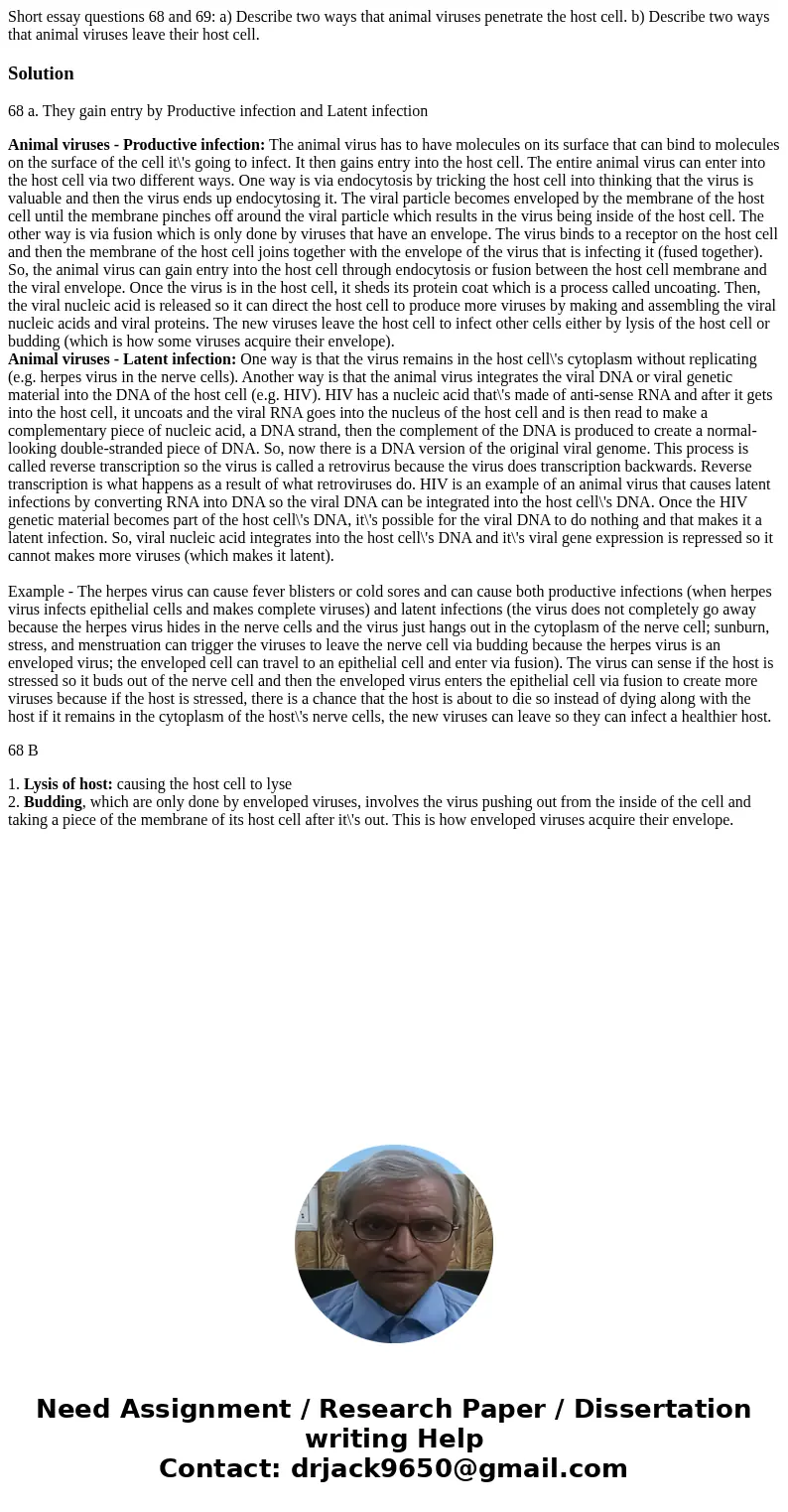Short essay questions 68 and 69 a Describe two ways that ani
Solution
68 a. They gain entry by Productive infection and Latent infection
Animal viruses - Productive infection: The animal virus has to have molecules on its surface that can bind to molecules on the surface of the cell it\'s going to infect. It then gains entry into the host cell. The entire animal virus can enter into the host cell via two different ways. One way is via endocytosis by tricking the host cell into thinking that the virus is valuable and then the virus ends up endocytosing it. The viral particle becomes enveloped by the membrane of the host cell until the membrane pinches off around the viral particle which results in the virus being inside of the host cell. The other way is via fusion which is only done by viruses that have an envelope. The virus binds to a receptor on the host cell and then the membrane of the host cell joins together with the envelope of the virus that is infecting it (fused together). So, the animal virus can gain entry into the host cell through endocytosis or fusion between the host cell membrane and the viral envelope. Once the virus is in the host cell, it sheds its protein coat which is a process called uncoating. Then, the viral nucleic acid is released so it can direct the host cell to produce more viruses by making and assembling the viral nucleic acids and viral proteins. The new viruses leave the host cell to infect other cells either by lysis of the host cell or budding (which is how some viruses acquire their envelope).
Animal viruses - Latent infection: One way is that the virus remains in the host cell\'s cytoplasm without replicating (e.g. herpes virus in the nerve cells). Another way is that the animal virus integrates the viral DNA or viral genetic material into the DNA of the host cell (e.g. HIV). HIV has a nucleic acid that\'s made of anti-sense RNA and after it gets into the host cell, it uncoats and the viral RNA goes into the nucleus of the host cell and is then read to make a complementary piece of nucleic acid, a DNA strand, then the complement of the DNA is produced to create a normal-looking double-stranded piece of DNA. So, now there is a DNA version of the original viral genome. This process is called reverse transcription so the virus is called a retrovirus because the virus does transcription backwards. Reverse transcription is what happens as a result of what retroviruses do. HIV is an example of an animal virus that causes latent infections by converting RNA into DNA so the viral DNA can be integrated into the host cell\'s DNA. Once the HIV genetic material becomes part of the host cell\'s DNA, it\'s possible for the viral DNA to do nothing and that makes it a latent infection. So, viral nucleic acid integrates into the host cell\'s DNA and it\'s viral gene expression is repressed so it cannot makes more viruses (which makes it latent).
Example - The herpes virus can cause fever blisters or cold sores and can cause both productive infections (when herpes virus infects epithelial cells and makes complete viruses) and latent infections (the virus does not completely go away because the herpes virus hides in the nerve cells and the virus just hangs out in the cytoplasm of the nerve cell; sunburn, stress, and menstruation can trigger the viruses to leave the nerve cell via budding because the herpes virus is an enveloped virus; the enveloped cell can travel to an epithelial cell and enter via fusion). The virus can sense if the host is stressed so it buds out of the nerve cell and then the enveloped virus enters the epithelial cell via fusion to create more viruses because if the host is stressed, there is a chance that the host is about to die so instead of dying along with the host if it remains in the cytoplasm of the host\'s nerve cells, the new viruses can leave so they can infect a healthier host.
68 B
1. Lysis of host: causing the host cell to lyse
2. Budding, which are only done by enveloped viruses, involves the virus pushing out from the inside of the cell and taking a piece of the membrane of its host cell after it\'s out. This is how enveloped viruses acquire their envelope.

 Homework Sourse
Homework Sourse